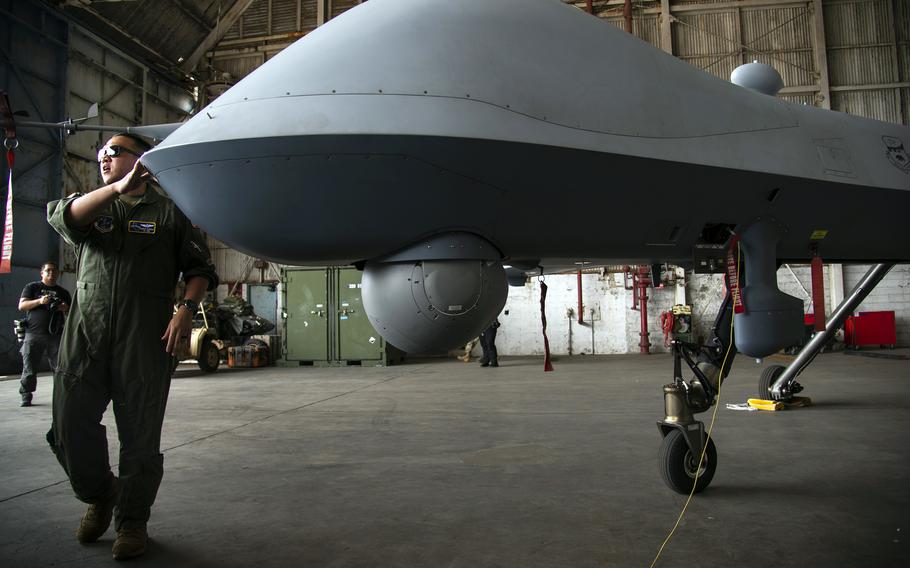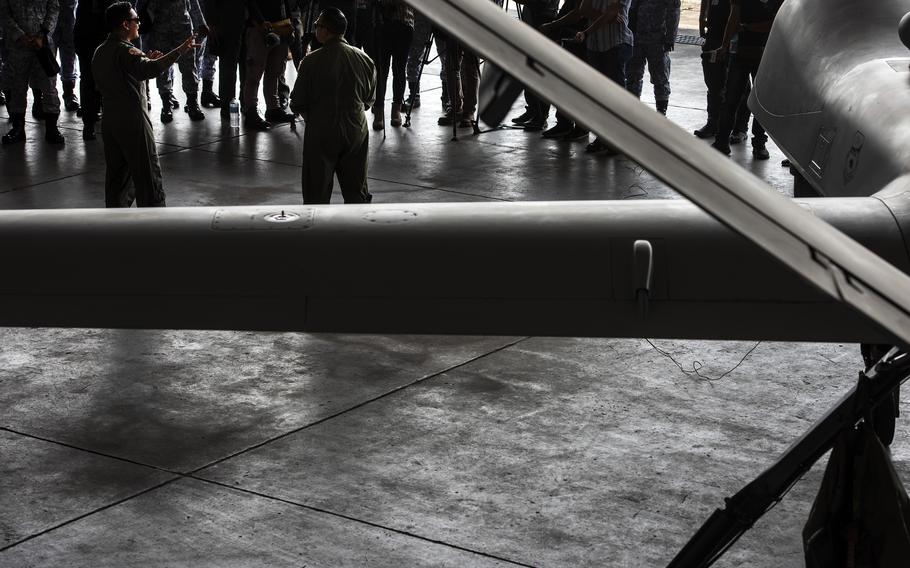
Capt. Angelo Tapalla, an unmanned aerial vehicle pilot with the California Air National Guard, briefs Philippine navy sailors about the MQ-9 Reaper at the former home of Naval Air Station Cubi Point, Philippines, Sunday, April 23, 2023. (Jonathan Snyder/Stars and Stripes)
SUBIC BAY, Philippines — The U.S. military has, for the first time, deployed some of its most lethal unmanned aircraft to the Philippines, where they’re participating in large-scale military drills this month.
A pair of MQ-9 Reapers – the same type of plane that carried out numerous strikes in combat zones over the past 16 years – are flying intelligence, reconnaissance and surveillance missions during the annual Balikatan exercise. This year’s drills involve 17,000 U.S. and Philippine troops.
“This is the first large scale integration of an unmanned platform into Philippine airspace,” Staff Sgt. Joseph Pagan, a California Air National Guard spokesman, said in an email Sunday to Stars and Stripes.
The drones from the California Guard’s 163rd Attack Wing are equipped with nose cameras and multi-spectrum targeting systems but no weapons. They were positioned Sunday at Cubi Point, a former U.S. naval air station in Subic Bay on the Philippines’ main island of Luzon.
The planes are supporting both land and sea maneuvers, Capt. Angelo Tapalla, a drone pilot with the California Guard, told reporters as they photographed one of the MQ-9s in a hangar.
Reapers, made by General Atomics of San Diego, can carry 3,000 pounds of ordnance and first saw combat in Afghanistan in 2007 and Iraq the following year. They conducted numerous missions there and in other parts of the Middle East and Africa.
In recent years, the Air Force has employed the drones in maritime environments.
The aircraft, which carry long-range radar and can provide commanders with full-motion video of the sea below, have practiced overseas close air support, search and rescue, maritime interdiction, strike coordination and reconnaissance and surveillance.
Eight Air Force MQ-9 Reaper drones – unarmed and configured for surveillance – and more than 150 airmen in the newly formed 319th Expeditionary Reconnaissance Squadron began a yearlong deployment to Kanoya Air Base in southern Japan in November.
The Reapers’ capabilities could come in handy in a place such as the South China Sea, Lt. Col. Brian Davis, who leads the 29th Attack Squadron at Holloman Air Force Base, N.M., told Stars and Stripes in September 2020.
“We are just as capable [at sea] without changing our weapons in any way,” he said of the drones.
The Reapers in the Philippines are equipped with new software that allows them to take off, fly and land at the push of a button with no aircrew outside of the United States, Tapalla said.
“The MQ-9 can operate in environments with minimal aircrew and equipment,” he said, noting that the Philippine mission is an example of agile combat employment.
Agile combat employment is the ability to move aircraft rapidly to a network of smaller airfields to avoid being targeted by missiles in the event of war. U.S. forces have been honing these skills across the Western Pacific.

Capt. Tim Nolan, left, and Capt. Angelo Tapalla, unmanned aerial vehicle pilots with the California Air National Guard, brief Philippine navy sailors about the MQ-9 Reaper at the former home of Naval Air Station Cubi Point, Philippines, Sunday, April 23, 2023. (Jonathan Snyder/Stars and Stripes)
The Reapers, along with personnel and support equipment flew to the Philippines on C-17 Globemaster III transports from West Virginia, New York and North Carolina Guard units, according to Maj. Ryan Chase, another California Guard pilot, at Cubi Point.
During missions, the drones are flown by pilots from the 104th Attack Squadron of the Tennessee Air National Guard based in Nashville, he said.
A drill on Wednesday in which U.S. and Philippine forces are to sink a large fishing boat off Luzon, will include Reapers providing full-motion video to commanders, Chase said.
“There’s not much difference between maritime and land operations,” he said, adding that the Reapers will help troops watch out for civilian shipping operating nearby.
A challenge for the Reaper airmen was coordinating this deployment with Philippine civil aviation authorities to safely operate in the islands for the first time, he added.